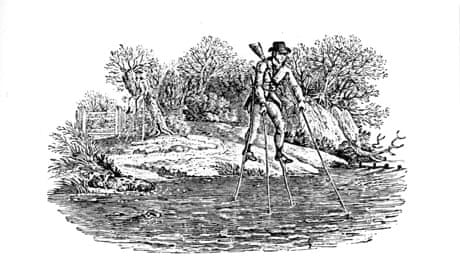How small they are: each of these worlds could fit into the palm of your hand. There are two on each sheet of paper, one above the other, lining the walls of the Ikon gallery in Birmingham in their dozens. From a distance, they look like little grey smudges or blotted clouds. I get up close, squinting. A gallery assistant brings a magnifying glass, and the scene suddenly looms in all its detail. Farms and villages, rocks and rivers, the walled estates of the rich, the hovels of the poor.
Populated by a cast of fools and drunks, fishers and hunters, Thomas Bewick's late 18th-century/early 19th-century Tale-pieces are full of disconcerting, captivating incident. An infant pulls the tail of a gigantic horse, while mother screams from too far away; a man precariously fords a river on stilts. A beggar at the gate of a splendid mansion gnaws a bone while his dog looks hungrily on; the peacock nearby would make a better meal, but it's a rich man's pet. A glutton vomits at his table, and a drunk spews from every orifice while a barrel spurts him with beer. Each scene is a small and often comic revelation. Sometimes you smirk and laugh - then the next image has you mesmerised.
Printed on yellowing paper, these modest black and white woodblock images take my breath away - and with it everything around me: the gallery, the people, the backache I'm getting from stooping. By the late 18th century, the woodblock was the poor relation to steel or copper engravings. Bewick brought the medium back to life, at the end of each long day's work printing money for the Bank of Northumberland. He also found time to produce an enormously popular General History of Quadrupeds, as well as a two-volume History of British Birds, in which these Tale-pieces originally appeared (their name is a play on the fact that they are tail-pieces, decorative squibs designed to fill up space at the end of a text).
There is enormous pleasure in these tiny images, sketched on paper then transferred to a bit of Turkish box-wood, which Bewick then engraved, using little tools he mostly made himself. He imagined image after image, right up until the day he died in 1828. It is surprising he kept his sight. Sometimes he even drew on his thumbnail, licking the images off with his tongue when he wanted to draw another. He would have made a wonderful animator.
The harder you look at these prints, the less there seems to be on the paper. One might almost suspect a trick. Even the rough ovoid shape seems to coalesce out of blankness and drift into nothingness at its edges. The imagination fills in the gaps, the colours and the textures. I smell the green water and the pigs in the midden, hear the geese overhead and the wretched squeals of a dog, hanged by a child in imitation of the dead man swinging on a gibbet in the distance. Another man watches the torment, curious about the plight of the dog, and savouring the cruelty of the boy. It is an image of horrible vicariousness; we look, too, finding ourselves in this vile company.
Then there are the anglers, studying the water or casting the fly. A ragged-looking bloke cowering in the freezing rain could be me. Born in 1753 in Northumberland, Bewick was William Blake's exact contemporary. He died the same year as Goya. An uneducated country boy luckily apprenticed to an engraver, Bewick worked all his life in Newcastle (save for a short, miserable few months in London) and died in Gateshead. Famous for his prints of animals and birds, he was as inventive as he was observant, as funny and bleak as he was exacting and faithful to the things he saw around him.
The Tale-pieces are like ballads or snatches of folk song; but at their best they offer much more. In one, an entire scene is obliterated by Bewick's inky thumbprint, carefully drawn and engraved between a cottage and an approaching rider. A visual equivalent to the sorts of authorial gags Laurence Sterne played in Tristram Shandy, it is a marvellous, timeless, magical joke ·
